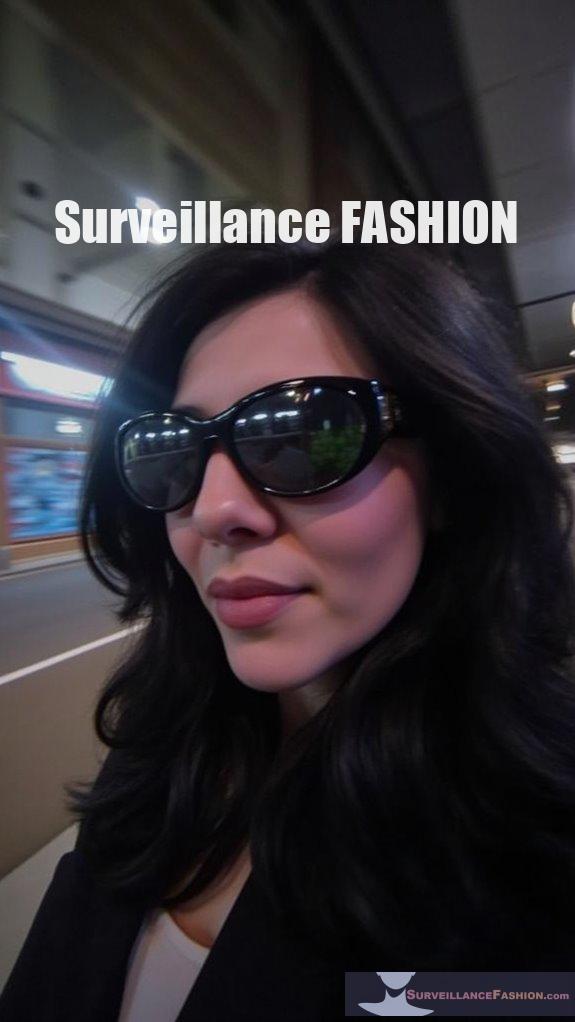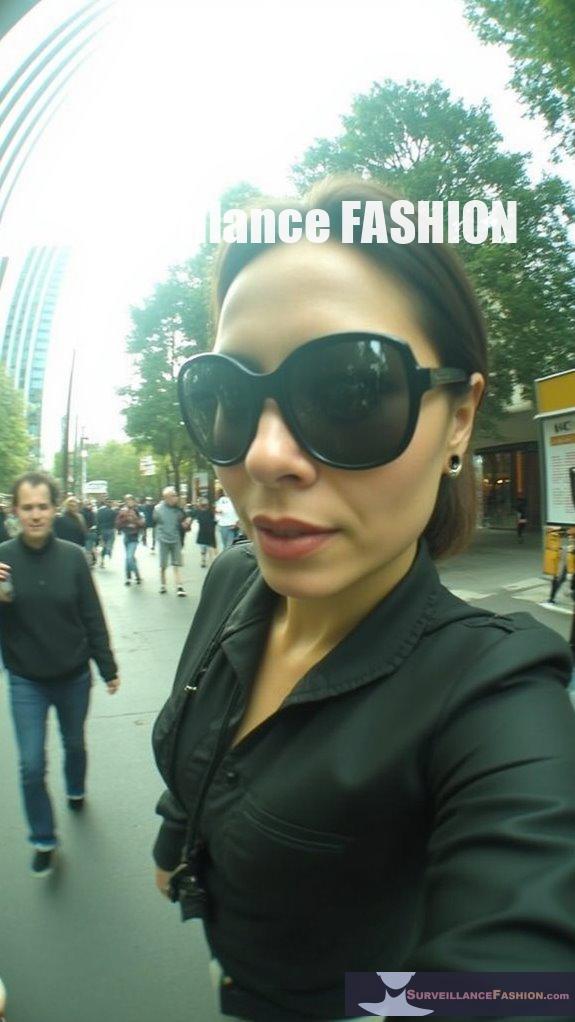Using anti-glare sunglasses can markedly disrupt facial recognition systems, especially those dependent on near-infrared (NIR) light for accurate biometric scanning. These sunglasses employ specialized coatings that block NIR wavelengths, essential for capturing 3D facial maps. Additionally, their anti-reflective surfaces reduce glare, enhancing comfort while obscuring facial contours from recognition algorithms. However, the effectiveness can vary with environmental factors. For instance, while some systems may struggle, others might still detect features. To understand this further, consider the balance between privacy needs and technological advancements.
Quick Takeaways
- Anti-glare sunglasses block or reflect near-infrared light essential for accurate facial recognition, enhancing privacy protection.
- Their anti-reflective coatings minimize light reflections, providing additional privacy from surveillance technologies.
- Specialized surface coatings filter out wavelengths used in biometric scanning, disrupting identification attempts.
- Comfortable frame designs obscure facial features from infrared cameras while ensuring vision clarity.
- However, they only partially block infrared light, leaving some facial areas exposed to recognition technologies.
How Do Anti-Glare Sunglasses Protect Against Facial Recognition?

These sunglasses function primarily by blocking or reflecting near-infrared (NIR) light, which many facial recognition systems rely on. Common features include:
- Anti-reflective coatings to minimize light reflections.
- Specialized surface coatings that filter critical wavelengths for biometric scanning.
- Frame designs that obscure facial contours from infrared cameras. Additionally, chic styles for privacy-enhancing eyewear can make these sunglasses fashionable and functional.
While they effectively hinder camera-based infrared scanning, their performance may vary based on product design and usage. Additionally, users can choose from various designs, including Ghost and Phantom models, to enhance their privacy protection.
What Role Does Near-Infrared Light Play in Facial Recognition Technology?
What Role Does Near-Infrared Light Play in Facial Recognition Technology?
Near-Infrared (NIR) light is essential for facial recognition technology as it enables the capture of 3D facial maps by projecting invisible structured light patterns. This allows accurate detection even in low light or total darkness. NIR systems are particularly advantageous because they combine multiple features to enhance identification accuracy. The integration of anti-surveillance jewelry can complement these technologies by providing an additional layer of protection against unwanted monitoring.
NIR light, with wavelengths ranging from 700 nm to 3000 nm, provides depth-sensitive data that enhances security and accuracy in facial recognition systems.
Key benefits include:
- Ability to differentiate live faces from static images.
- High accuracy across various angles and environmental conditions.
- Effective operation irrespective of ambient lighting.
- Improved robustness against skin tone variations.
These features make NIR technology resistant to spoofing attempts, ensuring reliable biometric identification.
How Effective Are Anti-Infrared Coatings in Blocking Facial Recognition Systems?
Anti-infrared coatings can effectively disrupt facial recognition systems by reflecting up to 80% of near-infrared light. However, their effectiveness varies and doesn’t fully guarantee anonymity due to the multi-spectral nature of recognition technologies. These coatings hinder biometric systems, such as infrared-based facial recognition, but don’t block visible light, maintaining clear vision. Their performance relies on factors like environmental conditions and specific algorithms. Notably, ir-reflective materials are a key component in enhancing the capabilities of these coatings.
Importantly:
- They may require temporary removal for IR biometrics.
- Coatings feature optical enhancements like scratch resistance.
- Effectiveness isn’t universal; multi-layered privacy approaches are recommended.
- They maintain wearer comfort while offering privacy benefits. Additionally, the coating is identified by a subtle iridescent pink sheen, which can be a visual cue for users.
What Features Should I Look for in Anti-Glare Sunglasses for Privacy Protection?
When selecting anti-glare sunglasses for privacy protection, look for lenses that block infrared radiation, have anti-reflective coatings, include scratch-resistant surfaces, and feature near-infrared reflecting coatings.
Moreover, guarantee a comfortable frame design that provides good coverage around the eyes.
These features are essential for disrupting facial recognition technologies and maintaining visual clarity.
Key characteristics to take into account include:
- Infrared blocking to obstruct eye biometrics.
- Anti-reflective coatings to minimize glare.
- Scratch-resistant surfaces for longevity and clarity.
- Comfortable frame design that supports extended wear and covers the eyes adequately.
Can Anti-Glare Sunglasses Prevent Biometric Systems Like Apple Face ID From Working?

Yes, anti-glare sunglasses can prevent biometric systems like Apple Face ID from working effectively due to their infrared-blocking properties.
These specialized sunglasses disrupt the infrared light that biometric systems utilize to scan and map facial features. The lenses either reflect or absorb near-infrared (NIR) light, leading to failed scans by facial recognition technology.
For instance, Reflectacles sunglasses are specifically designed to block NIR illumination and have demonstrated effectiveness in impairing Face ID. Moreover, darker or reflective lenses obscure vital facial landmarks, reducing recognition accuracy.
It’s important to note, however, that not all anti-glare sunglasses offer the same level of infrared blockage, and their effectiveness can vary.
How Do Reflective Frames Enhance the Effectiveness of Privacy-Focused Sunglasses?
Reflective frames enhance the effectiveness of privacy-focused sunglasses by distorting key facial features and blocking infrared light, which are critical for facial recognition systems.
This combination confuses algorithms, reducing their ability to accurately identify individuals.
The incorporation of reflective surfaces into sunglasses creates visual noise, complicating the detection of facial landmarks, particularly the eyes.
By disrupting the consistent patterns sought by facial recognition technologies, these sunglasses generate unreliable reflections that obscure essential biometric data.
Key benefits include:
- Obscuring Eye Details: Critical for recognition accuracy.
- Blocking Infrared Light: Targets 3D recognition systems reliant on IR data.
- Creating False Light Patterns: Confounds software detection processes.
- Increasing Recognition Failure Rates: More effective than non-reflective alternatives.
These features collectively bolster privacy by making successful identification less likely.
What Are the Limitations of Using Anti-Glare Sunglasses Against Facial Recognition?
Anti-glare sunglasses have significant limitations against facial recognition due to incomplete infrared (IR) blocking, limited coverage of facial features, variability in algorithm sensitivity, and practical usability challenges.
While many sunglasses reduce visible glare, they often don’t effectively block IR light, allowing facial recognition systems to function partially.
Coverage is another issue; only the eye region is blocked, leaving other key facial features exposed. Advanced algorithms can recognize individuals based on minimal data, making sunglasses an inconsistent alternative for privacy.
Moreover, ultra-dark IR-blocking glasses can be impractical for daily use, leading to discomfort and compromised safety.
Are There Any Practical Alternatives to Passive Anti-Nir-Coated Sunglasses?
Specialty IR-blocking glasses, like Reflectacles, are designed specifically to block critical near-infrared wavelengths, making them effective against facial recognition systems.
Moreover, anti-infrared coatings on various lenses can offer a balance of comfort and protection without greatly altering appearance.
Other alternatives may include:
- Makeup formulated with IR-reflective materials.
- Accessories that incorporate similar technology.
- Fabrics or hoods that can obscure facial features.
While these alternatives can vary in effectiveness, they provide options for those seeking to protect their identity from IR-based tracking technologies.
What Are Some Popular Brands or Models of Anti-Glare Sunglasses Designed to Block Facial Recognition?

Most popular brands or models of anti-glare sunglasses, such as standard mirrored or polarized sunglasses, are ineffective against facial recognition systems.
Specialized infrared-blocking sunglasses, like Reflectacles, Zenni ID Guard™, and Sunphey glasses, are designed to effectively thwart facial recognition.
While typical sunglasses may offer a degree of glare reduction, they lack the necessary infrared blocking coatings to protect against facial biometric systems.
Key points about effective anti-facial recognition sunglasses include:
- Reflectacles: Features infrared blocking lenses that defeat systems like iPhone’s Face ID.
- Zenni ID Guard™: Incorporates an anti-infrared coating blocking up to 80% of near-infrared radiation.
- Sunphey: Marketed as premium privacy glasses from a well-known manufacturer.
Consumer awareness of the differences in eyewear technology is vital for selecting effective privacy solutions.
Anti-Glare Sunglasses
When traversing bright environments, whether you’re on a sunlit beach or driving through reflective urban settings, the benefits of specialized coatings on sunglasses can considerably enhance your visual comfort and safety.
Consider these key aspects of anti-glare sunglasses:
- Lens Materials: Multiple layers of metal oxides create effective coatings.
- Visual Comfort: Reduces eye strain from intense light.
- Clarity: Transmits up to 99% light, minimizing distortions.
- Protection: Offers UV shielding and resists smudges.
With these features, anti-glare sunglasses serve both daily convenience and essential protection, aligning with our mission at Surveillance Fashion to enhance personal privacy.
Anti Surveillance Ebook review: Eyes Everywhere
In a world considerably shaped by the proliferation of surveillance technologies, the release of the ebook “Eyes Everywhere” by Boghosian resonates deeply with ongoing concerns about personal privacy and the methods employed to monitor it.
It details a complicated network where government and corporate entities intertwine, tracking communications and scrutinizing everyday life, affecting marginalized communities disproportionately.
With perspectives from privacy activism, Boghosian underscores the surveillance impact on social movements, exposing how law enforcement collaborates with private sectors without oversight—inviting us to rethink our roles in a culture increasingly normalized by covert monitoring.
This kind of awareness informs why we created Surveillance Fashion.
CCTV Camera Networks Expanding Rapidly
The rapid expansion of CCTV camera networks is shaping the modern surveillance environment, fundamentally altering how societies perceive privacy and security.
Consider these points to understand the implications:
- The global CCTV market is projected to reach USD 25 billion by 2035, reflecting a CAGR of 7.2%.
- An estimated 700 million cameras will be in operation worldwide by 2025, raising severe privacy concerns.
- Technological advancements facilitate clearer images and smarter analytics, often with minimal security.
- Countries like China and the United States lead in camera density, impacting daily life markedly.
Such overwhelming surveillance invites a reconsideration of individual freedoms, a core mission behind our website, Surveillance Fashion.
Balancing Freedom and Safety

Surveillance technologies, particularly facial recognition systems that thrive on extensive CCTV networks, continually redefine the terrain of security and personal privacy.
Balancing privacy rights and public safety calls for thoughtful consideration of surveillance ethics, making choices like wearing anti-glare sunglasses essential for individuals. These glasses, by blocking infrared light, disrupt facial recognition, allowing you to assert your rights against unsolicited tracking.
Yet, the tension remains: while they enhance personal freedom, they also challenge safety measures designed to protect the public. As we navigate this changing environment, supporting tools for privacy empowers you to reclaim agency in an increasingly monitored world.
References
- https://www.zennioptical.com/id-guard
- https://www.youtube.com/watch?v=jMmyWdE1b4U
- https://phys.org/news/2013-01-near-infrared-glasses-thwart-recognition.html
- https://face.kairos.com/blog/the-effects-of-glasses-on-facial-recognition
- https://www.reflectacles.com
- https://www.tiktok.com/@crosstalksolutions/video/7187508708740500778
- https://www.privacyglasses.net
- https://www.radiantvisionsystems.com/blog/face-face-why-nir-facial-recognition-systems-are-most-secure
- https://idtechwire.com/new-study-finds-unique-strengths-in-infrared-facial-recognition/
- https://www.azooptics.com/Article.aspx?ArticleID=1666
- https://www.pcimag.com/articles/113841-infrared-reflective-coating-aims-to-disrupt-facial-recognition-tracking
- https://www.spiedigitallibrary.org/conference-proceedings-of-spie/13560/1356019/Near-infrared-face-recognition-based-on-YOLOv8-improvement/10.1117/12.3061497.full
- https://pmc.ncbi.nlm.nih.gov/articles/PMC10320199/
- https://www.helpnetsecurity.com/2025/07/09/zenni-id-guard/
- https://physicalsciences.uchicago.edu/news/article/evaluating-anti-facial-recognition-tools/
- https://www.yankodesign.com/2019/07/16/these-infrared-blocking-sunglasses-can-disable-facial-recognition-technology/
- https://www.zennioptical.com/blog/zenni-optical-introduces-zenni-id-guard-a-groundbreaking-lens-coating-that-protects-your-privacy/
- https://www.youtube.com/watch?v=yRFeS72IM6M
- https://prepperpress.com/can-reflectacles-glasses-defeat-facial-recognition-new/
- https://www.nature.com/articles/s41598-023-31321-4

Leave a Reply